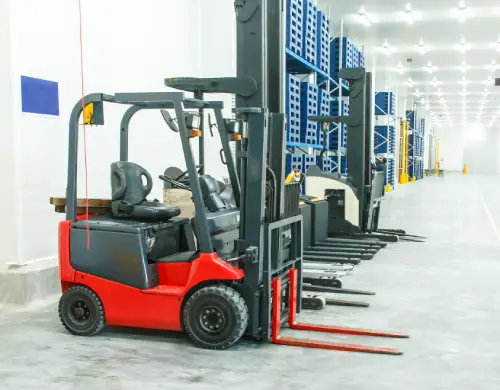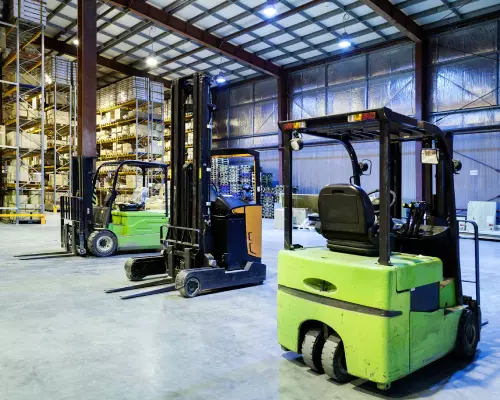Forklifts are industrial trucks that are designed to move materials across short distances. There are various forklift types, each having a unique function. From reach trucks and side loaders to standard forklifts, these machines lift pallets, raw materials, boxes, and even containers.
When operating forklifts, either in a warehouse or within the compounds of a facility, it’s important that all operators practice proper operating procedures, including parking. Improper parking can cause injuries, accidents, and damage to cargo or the facility.
In this guide, we’ll be teaching you the correct way to park forklifts, and everything there is to know about forklift parking. Here’s a quick summary of what content this guide features:
How to Park a Forklift
When it comes to parking forklifts, there are various things that need to be considered. Parking forklifts incorrectly or in areas that are not properly demarcated can lead to equipment and cargo damage, as well as injuries.

In this guide, we will teach you how to park a forklift correctly, according to the official Occupational Safety and Health Administration (OSHA) guidelines and recommendations. It’s best to follow these steps in sequence and refer to the official OSHA guidelines that can be found here.
1. Select an Appropriate Parking Area
You’ll first need to identify an appropriate parking area for your forklift. It’s best to use a designated forklift parking area, which is clear of any obstructions and properly demarcated.
Forklifts should be parked on flat and hard surfaces. Inclines or declines should be avoided whenever possible. This area should also not obstruct access to emergency exits, stairways, or fire extinguishing equipment.
Lastly, parking areas should not block any traffic lanes for other material handling equipment or pedestrian walkways within the warehouse. It’s also best to park away from any heat, machinery, storage racks, and cargo.
2. Position Your Forklift
Safely operate the forklift and move it to the designated area. Turn slowly and ensure that the forklift is maneuvered at a speed that is manageable for proper parking.
When necessary, make use of the forklift horn, headlights, and brake lights to warn warehouse personnel or other forklifts if they are moving too close. Also, ensure that you check and assess your surroundings from time to time by moving your head and using the mirrors.
Lastly, ensure that the forklift is in its designated parking area and has come to a complete stop. Also, make sure that you straighten the forklift wheels so that they are aligned with the forklift.
3. Fully Engage the Parking Brake
Once the forklift is parked, set the gear to neutral and engage the parking brake. Some forklifts have a foot-operated parking brake located near the brake pedal – typically it’s smaller and placed further inside.
On the other hand, some forklifts also have hand-activated parking brakes that look like a lever. Simply place the brake into the parking position to engage the parking brake.
If you’re unsure where to locate the parking brake on your forklift, then it’s best to check the operating manual or with the manufacturer or leasing company, as parking brake positions and types can differ between manufacturers and models.
4. Lower Carriage and Forks
When parking, it’s important to lower the carriage using the hydraulic controls until the forks touch the ground. Usually, the heel of the fork (the back part that’s closest to the forklift cab) will make contact with the ground first.
Also, remember to park your forklift so that the forks are positioned against a wall or away from any busy aisles or walkways.
5. Tilt Mast Forward until Forks are Parallel To the Ground
A forklift mast is the main support structure that allows the carriage to move upward and downward. Through a tilt cylinder, the mast is able to change its angle forward and backward.
Now that the heel of the fork has made contact with the ground, it’s important to make them parallel to the ground, by moving the mast of the forklift accordingly (either forward or backward).
Leaving the forks raised off the ground is dangerous for mainly two reasons. Firstly, it may cause instability, causing the forklift to tilt or even tip over if the forks are raised high up. Secondly, it can cause an obstruction that people may accidentally walk into.
6. Turn Off Forklift and Remove the Key
Once the forks are parallel to the ground, it’s time to power down the forklift. To turn off the engine, switch the key to the OFF position and remove the key.
While some forklifts may have an ON/OFF switch to power down the forklift, you should still remove the key for safety reasons.
7. Dismount from the Forklift Cab
In the last step, you’ll need to dismount from the forklift cab (also referred to as the cabin). Do this by lifting yourself up from a seated position and getting down the forklift slowly. If you’re operating a stand-up forklift, simply step out.
In accordance with OSHA guidelines, you should dismount without jumping or any unnecessary movement. Whenever possible, attach tire chocks to the front and back wheels on both sides of the forklift to keep it stable and in place. (typically done for larger outdoor forklifts).
For more information on the proper and safe use of forklifts (including parking procedures), please visit the official OSHA guidelines.
What Skills Are Required to Park a Forklift?
Forklifts are powered industrial trucks that fall under the category of material handling equipment and are used in various types of industries. Its main purpose is to increase productivity by moving, transferring, and lifting materials from one area or location to another.

Using a forklift requires formal training to ensure proper use of equipment for safe workplace practices and to avoid potential accidents. Forklift parking should also be assessed separately when training is conducted.
OSHA has defined the standards that should be incorporated into training and certifications, when it comes to operating forklifts. In order to park a forklift, it’s vital that the operator is acquainted with the following forklift operating skills:
- Mounting and dismounting
- Starting and stopping
- Operating at speed
- Steering, turning and changing direction
- Traveling on inclines
- Safe travel practices
- Visibility
- Tipover
If a forklift operator is not familiar with these 8 prerequisites, it’s highly recommended to conduct a full training, before he or she practices parking a forklift.
Where to Park a Forklift
In any operation – whether in a warehouse, manufacturing plant or distribution center – it’s extremely important that proper safety measures are adopted.

Therefore, it’s always best to ensure that all material handling equipment (including forklifts) is parked properly in a designated area that doesn’t cause any form of obstruction and minimizes the risk of workplace accidents. Here are three recommendations on where to park a forklift safely.
- Designated Forklift Parking – Preferably, a forklift should always be parked at a designated forklift parking area that is clearly demarcated. This area is usually a place in the warehouse free from any obstructions and is accessible only to authorized operators. A forklift parking area is also typically positioned away from aisles, walkways and heavy traffic areas.
- Forklift Charging Stations – Forklifts can also be parked at the forklift charging station. Charging stations should also be positioned out of heavy traffic areas and away from aisles and walkways. While parked, forklifts can be recharged (only applicable to eclectic forklifts). Take note that additional parking positions may be required if the number or forklifts exceed the number of charging stations.
- Open Spaces – If no charging stations or dedicated forklift parking area is available (typically in smaller warehouse operations) forklifts can also be parked in open spaces that are deemed safe. Take note that it should be a level surface without any incline or decline. Forklifts should also be parked away from heavy traffic, as well as aisles and walkways. They should not cause any obstruction to ongoing operations.
Places to Avoid Parking Forklifts
Parking forklifts improperly or at locations that are not designated can lead to workplace accidents. Therefore, it’s also important to take note of locations and areas where forklift parking should be avoided.
Parking forklifts in these areas can greatly increase the risk of workplace accidents involving forklifts, which should be avoided at all costs.
- Unlevel Surfaces – Forklifts should not be parked in an incline or decline surface. The lightest forklifts weigh about 2 tons and any unintended movement may result in injury to personnel or unwanted damage to property or cargo.
- Near Emergency Lanes – Forklifts should also never block areas such as fire exits or access to first aid kits and fire fighting equipment. In case of emergency situations access to these areas is vital.
- Near Heat – As forklifts are powered by fuel or batteries, parking near sources of heat, flame, or unsafe ignitions should be avoided at all times. Prolonged exposure may cause forklifts to combust.
- Near Doors & Walkways – Forklifts should also not be parked near doors or walkways. As walkways and paths should have proper demarcations, forklifts should stay clear of them.
- In-Between Aisles – In warehouses, space is typically limited. When a forklift is parked in-between aisles it blocks storage racks and access to cargo, as well as other forklifts and pallet trucks.
- Near Cargo – Forklifts should also not be parked near cargo because it can be a source of possible damage or cause obstruction if that cargo needs to be moved.
- Near Loading Bays – Loading bays are open spaces for many types of handling equipment so that personnel have unrestricted access to load and unload cargo. Forklifts parked near loading bays may block access to them which may affect productivity.
- Non-Designated Areas – Forklifts should only be operated within clearly defined areas in the warehouse (usually from the loading bay to the storage racks). Forklifts parked in non-designated areas can lead to obstruction and also pose various potential safety issues.
Important Tips on Parking Forklifts
In this guide, we’ve shared a step-by-step process on how to park a forklift, the best places to park forklifts, and what areas to avoid parking at. In the following section, we’ll take a closer look at some of the best practices and additional tips that may be helpful to you.
Keep Forklift Drivers Informed of Process Changes
Continuous improvement programs may change certain internal processes. Therefore, it’s important that current standard operating procedures (SOPS) and other processes are often revisited and adapted if required.
This is also important to forklift operating manuals, parking areas, and general forklift operating guidelines. It’s also good practice to keep all forklift operators up-to-date on these types of changes.
Train Forklift Drivers According to OSHA Guidelines
The Occupational Safety and Health Administration sets the industry standard for operating forklifts, which also includes parking. Therefore, it’s important that all forklift operators understand the correct procedures.
Training that is aligned with the latest OSHA standards on forklift parking (as well as how to generally operate a forklift) should be conducted with all forklift operators on a regular basis.
It’s also critical to evaluate an operator’s knowledge in handling equipment to ensure proper operation and safety at the workplace. Regular checking with objective scoring allows for reviews that address needed improvement if necessary.
Establish Designated Forklift Parking Areas
All warehouses regardless of size should have designated areas where forklifts should be parked. This area should be away from any traffic, as well as cargo, aisles, and walkways.
Forklift parking areas are typically demarcated with floor tape or through an area that is only accessible to forklifts. It’s also good practice if the forklift parking area is clearly signposted.
Lastly, the dedicated forklift parking space should not impede access to common and emergency areas for personnel.
Indicate Where No Forklift Parking Is Allowed
Smaller warehouses or manufacturing facilities may not have any dedicated forklift parking areas, although this is not recommended. In these scenarios, forklifts are sometimes parked in other non-obstructing areas.
As the OSHA mentions that an unattended vehicle is a danger to the operator and others, it’s important that proper signages must be placed in strategic areas with the intention of reminding forklift operators to park in the designated areas only, or where forklifts must not be parked.
Feel free to read the section on the areas where forklifts should not be parked, for more information.
Practice Proper Forklift Maintenance
Ensuring that forklifts are well maintained is important as they have many moving parts that may need to be replaced if worn or damaged. A faulty parking brake for example can lead to accidents and injury.
A good guideline to follow is for every 250 hours, check and blow out brake dust and every 2,000 hours to inspect brake drums. Lastly, for every 5,000 to 7000 hours, replace brake shoes.
Please take the above as guidelines only! For more specific information, please coordinate with your forklift manufacturer or leasing company and follow the maintenance schedule carefully and accurately.
Separate Forklift Paths and Parking Areas from Walkways
Designated walkways are always to be used even if forklifts are not in operation. Visible signages can be added so that pedestrians assume forklifts are moving in the area at any given time.
For safety reasons, forklift paths and parking areas should not be near any walkways within the warehouse. This should also be practiced for forklifts that are operated outdoors.

Get Free Course Access
If you enjoyed the article, don’t miss out on our free supply chain courses that help you stay ahead in your industry.

Andrew Lin
Co-Founder & Writer
at freightcourse
About the Author
Andrew is a multi-business owner with over 12 years of experience in the fields of logistics, trucking, manufacturing, operations, training, and education.
Being the co-founder of freightcourse has given him the ability to pursue his desire to educate others on manufacturing and supply chain topics.
Follow us